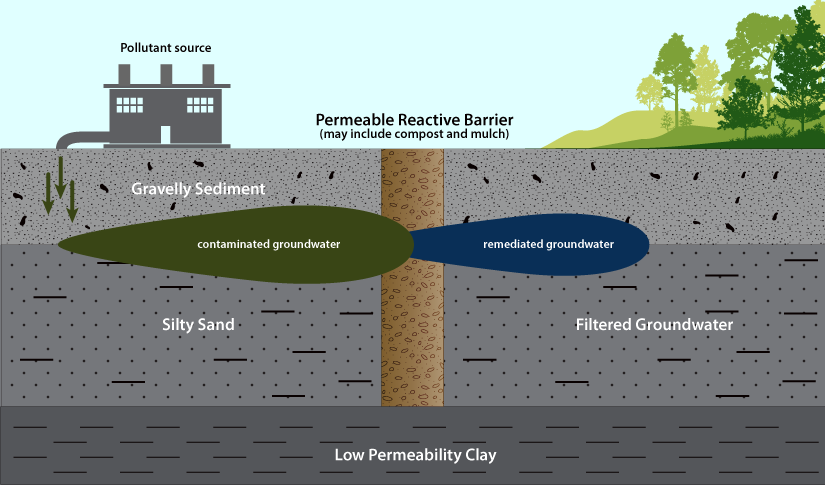Compost bioremediation is a set of technologies that use bacteria and fungi in mature, cured compost to sequester or break down contaminants in soil and water. Compost is effective in degrading or altering many types of contaminants, including chlorinated and non-chlorinated hydrocarbons, wood preservatives, solvents, heavy metals, pesticides, petroleum products, and explosives. Compost helps return contaminated sites to pre-contamination condition by improving soil properties and providing nutrients that facilitate plant growth. This page focuses on the use of compost in surficial soil remediation and biological reactive barriers. Go to Riparian Restoration for a discussion on constructed wetlands, another bioremediation technology that utilizes compost.
Remediation of Surface Soil
It is appropriate and sometimes preferable to excavate and treat contaminated soils in-place under some conditions. Monitoring may be required to ensure contaminants do not migrate. Consult applicable regulatory agencies prior to commencing remediation activities. In the event that contamination is shallow, till soil to a shallow depth and mix compost into the soil.
Biological Reactive Barriers
A biological reactive barrier is a bioremediation zone constructed in a contamination zone to treat contamination. A trench is constructed and filled with organic materials such as compost, mulch, manure, straw, and other additives such as bentonite binder. As groundwater flows through the bioremediation zone, organic materials degrade, sequester, or alter contaminants into safer chemicals.

Where to Use Treatment
Compost bioremediation treats soil contaminated with the following:
- Heavy metals
- Pesticides
- Petroleum hydrocarbons
Limitations
Not effective on some contaminants
Benefits
- Sequesters specific contaminants
- Breaks down specific contaminants in soil or water
- Provides additional benefits associated with compost use, such as increasing plant establishment and health
Design Considerations/Plans and Details
Design compost to treat specific contaminants at specific sites
Resources
- USEPA Bioremediation Overview
- USEPA – The Use of Soil Amendments for Remediation, Revitalization, and Reuse
- USEPA – In Situ and Ex Situ Biodegradation Technologies for Remediation of Contaminated Sites
Research
- Adams, Godleads Omokhagbor. Bioremediation, Biostimulation and Bioaugmention: A Review. International Journal of Environmental Bioremediation & Biodegradation 2015, Vol. 3, No. 1, 28-39.
- Chen, Ming et al. Bioremediation of soils contaminated with polycyclic aromatic hydrocarbons, petroleum, pesticides, chlorophenols and heavy metals by composting: Applications, microbes and future research needs. Biotechnology Advances 33 (2015) 745-755.
- Kastner, Matthias and Miltner, Anja. Application of compost for effective bioremediation of organic contaminants and pollutants in soil. Appl Microbiol Biotechnol (2016) 100:3433-3449.
Resources
For more information contact: Organic Materials, organics@calrecycle.ca.gov

